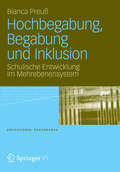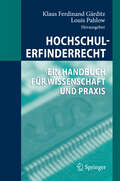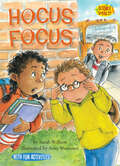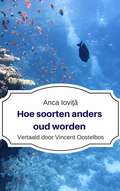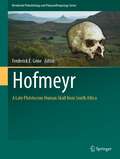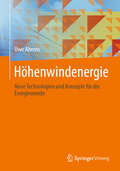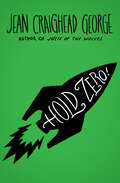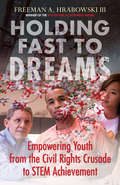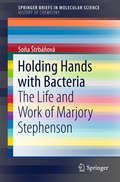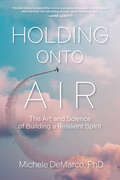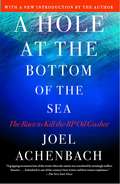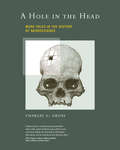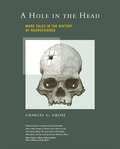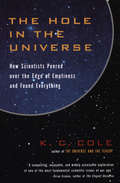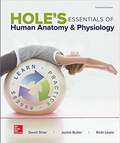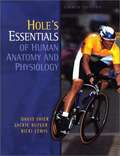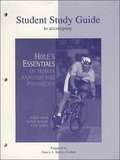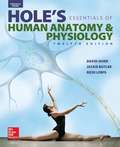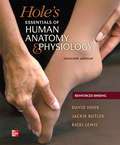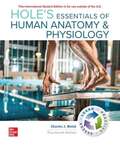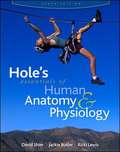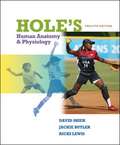- Table View
- List View
Hochbegabung, Begabung und Inklusion
by Bianca Elke PreußHochbegabung wird vielfach als pädagogisches Phänomen betrachtet, weniger als Gegenstand empirischer Bildungsforschung.Vor dem Hintergrund von Schulentwicklungsprozessen in schulischen Netzwerken wird in dieser Studie ein solcher Ansatz gesucht. Als empirisches Fallbeispiel dienen die Kooperationen "Hochbegabung fördern" in Niedersachsen, die seit 2003 als flächendeckendes, bildungspolitisches Konzept zur bildungsgerechten und durchlässigen Entwicklung von Begabungen eingeführt wurden. Über den Ansatz der Educational-Governance-Forschung wird auf Basis qualitativer Daten gezeigt, welchen Beitrag die Leitidee 'Hochbegabungsförderung' perspektivisch für Inklusion leistet und wie sich in diesem Kontext produktive Schulentwicklung auf den verschiedenen Steuerungsebenen von Schulverwaltung und Schule realisiert.
Hochschulerfinderrecht
by Louis Pahlow Klaus Ferdinand GärditzMit dem Wegfall des Hochschullehrerprivilegs 2002 kommen auf die deutschen Hochschulen neue Aufgaben zu. Forschungsergebnisse müssen nun auf Ihre Verwertbarkeit geprüft, Patentanmeldungen getätigt und zahlungskräftige Abnehmer gefunden werden. Zudem stellen sich ganz neue Fragen in Bezug auf die Lehr- und Forschungsfreiheit, die Einwerbung von Drittmitteln und die Kooperationen mit außeruniversitären Forschungseinrichtungen sowie der Industrie. Das vorliegende Handbuch will die genannten Fragenkreise im Spannungsfeld von öffentlichem Dienstrecht, Hochschulrecht einerseits, dem Recht des Geistigen Eigentums andererseits umfassend beantworten. Das Werk richtet sich an die Praxis in den Hochschulen, aber auch in der Industrie und Rechtsberatung.
Hocus Focus (Science Solves It!)
by Sarah WillsonSolve kid-sized dilemmas and mysteries with the Science Solves It! series. These fun books for kids ages 5–8 blend clever stories with real-life science. Why did the dog turn green? Can you control a hiccup? Is that a UFO? Find the answers to these questions and more as kid characters dive into physical, life, and earth sciences. Jack and Gina are not really thrilled about having to wear glasses. Hank, the class smart aleck, just makes things worse with his teasing. But when a class trip to the rock quarry almost ends in disaster, Jack, Gina, and Hank learn to see things a little more clearly. Books in this perfect STEM series will help kids think like scientists and get ahead in the classroom. Activities and experiments are included in every book! (Level Two; Science topic: Vision)
Hoe soorten anders oud worden
by Anca IovițăVeroudering is een puzzel die opgelost kan worden. Het proces van veroudering wordt van oudsher bestudeerd in enkele biologische modelorganismen zoals fruitvliegjes, wormen en muizen. Wat al deze soorten gemeen hebben is hun korte levensduur. Voor een laboratoriumstudie op een budget is dit ideaal. Het is een goede strategie voor de korte termijn. Wie heeft er nou tijd om soorten te bestuderen die decennia leven? Maar verschillen in levensduur tussen soorten zijn vele malen groter dan de variatie in levensduur die in het lab kan worden aangetoond. Daarom heb ik talloze informatiebronnen bestudeerd in een poging veel uiterst specialistisch onderzoek samen te brengen in één goed leesbaar boek. Ik wilde door de bomen het bos weer kunnen zien. Ik wilde in enkele duidelijke en logische stappen openbaren hoe soorten anders oud worden. Dit boek is mijn poging om dat te doen. Welke mechanismen staan aan de basis van deze ongelijkheid in veroudering tussen soorten? Hoe worden soorten anders oud? Ik heb er opzettelijk voor gekozen het antwoord op deze vraag in eenvoudige taal te formuleren. Onderzoek naar veroudering is te belangrijk om te verhullen met formeel wetenschappelijk jargon. Dit boek zou niet hebben bestaan zonder de uitvinding van groene thee, bibliotheken en het internet. De hoeveelheid data die ik heb doorgespit om de essentiële patronen te achterhalen is immens. Toch is dit boek niet uitputtend. Het is geen droog academisch handboek. Ik heb geprobeerd een onderwerp levendig te maken dat ontzettend belangrijk is voor het verlengen van het menselijke leven. Jij alleen kunt bepalen of ik hierin geslaagd ben. ********** Inhoudsopgave ********** Door de bomen het bos terugvinden Betrouwbaar is goed De wiskunde van de veroudering De snelheid van senescentie Case: veroudering bij vissen Hoe schat je chronologische leeftijd Rustig aan Tem
Hofmeyr: A Late Pleistocene Human Skull from South Africa (Vertebrate Paleobiology and Paleoanthropology)
by Frederick E. GrineThis edited volume provides the historical and geological background, as well as the details pertaining to the morphology and morphometric assessments, of a singular human cranial specimen from the Late Pleistocene discovered in Hofmeyr, South Africa. The chapters are divided into 4 main sections. Section 1 discusses the discovery and historical context of the skull, while section 2 addresses its geological and geochronological contexts through dating and stable isotope analyses. Section 3 details the general morphological and morphometric analyses (description, 3-D reconstruction, morphological comparisons), and section 4 details the specific morphological analyses performed (inner ear, dentition, endocranial morphology and size). The volume will be of interest to professional and student paleoanthropologists interested in the later phases of human evolution.
Höhenwindenergie: Neue Technologien und Konzepte für die Energiewende
by Uwe AhrensDieses Buch stellt wesentliche Technologien zur Nutzung der Windenergie vor und zeigt Lösungsmöglichkeiten auf, wie eine rentable Energieversorgung umgesetzt werden kann. Im Fokus steht die Höhenwindnutzung. Die Windenergie aus der Luft ist eine der vielversprechendsten Technologien, um die Energiewende wirtschaftlich zu gestalten. Präsentiert werden die JoJo-Technologien, die Fliegende Generator Technologien und weitere Konzepte zur Höhenwindenergieernte. Darüber hinaus bietet das Buch Informationen zum Materialverbrauch, zur Recyclingfähigkeit, zu Verschattungseffekten, zur Skalierbarkeit, zur Grundlastfähigkeit, zum Klimafußabdruck (GWP), zur Landschaftsbildbeeinflussung, zur Geräuschbelastung und zur E-Mobilität.Das Buch erläutert, wie wir in Zukunft unseren gesamten Energiebedarf (Strom, Mobilität und Wärme) ohne fossile Brennstoffe decken können, ohne die Wettbewerbsfähigkeit unserer Wirtschaft zu gefährden. Ein Wegweiser für Ökonomen, Umweltschützer und Politiker.
Hold Zero!
by Jean Craighead GeorgeCraig and his friends have a big secret—they&’ve built a real, working rocket. But will the countdown to takeoff begin before they&’re discovered? Best friends Craig, Steve, Johnny, and Phil have spent months building a rocket—not some model or a toy, but a real rocket, with boosters and a launch pad and a remote control panel. Even better, they&’ve managed to pull off the whole project in secret. The boys can&’t wait to launch their rocket . . . but then their parents find out what they&’ve been up to and tell the police. When they see how sophisticated the rocket really is, the police insist on inspecting all the blueprints and calculations, and the boys find themselves in a lot of trouble. Will their project go up in smoke? This ebook features an illustrated biography of Jean Craighead George, including rare photos from the author&’s personal collection.
Hold Zero!
by Jean Craighead GeorgeCraig and his friends have a big secret—they&’ve built a real, working rocket. But will the countdown to takeoff begin before they&’re discovered? Best friends Craig, Steve, Johnny, and Phil have spent months building a rocket—not some model or a toy, but a real rocket, with boosters and a launch pad and a remote control panel. Even better, they&’ve managed to pull off the whole project in secret. The boys can&’t wait to launch their rocket . . . but then their parents find out what they&’ve been up to and tell the police. When they see how sophisticated the rocket really is, the police insist on inspecting all the blueprints and calculations, and the boys find themselves in a lot of trouble. Will their project go up in smoke? This ebook features an illustrated biography of Jean Craighead George, including rare photos from the author&’s personal collection.
Holding Fast to Dreams
by Freeman A. Hrabowski IIIAn education leader relates how his experiences with the civil rights movement led him to develop programs promoting educational success in science and technology for African Americans and others. When Freeman Hrabowski was twelve years old, a civil rights leader visited his Birmingham, Alabama, church and spoke about a children's march for civil rights and opportunity. That leader was the Reverend Martin Luther King Jr., and that march changed Hrabowski's life. Until then, Freeman was a kid who loved school and solving math problems. Although his family had always stressed the importance of education, he never expected that the world might change and that black and white students would one day study together. But hearing King speak changed everything for Hrabowski, who convinced his parents that he needed to answer King's call to stand up for equality. While participating in the famed Children's Crusade, he spent five terrifying nights in jail--during which Freeman became a leader for the younger kids, as he learned about the risk and sacrifice that it would take to fight for justice. Hrabowski went on to fuse his passion for education and for equality, as he made his life's work inspiring high academic achievement among students of all races in science and engineering. It also brought him from Birmingham to Baltimore, where he has been president of the University of Maryland, Baltimore County for more than two decades. While at UMBC, he co-founded the Meyerhoff Scholars Program, which has been one of the most successful programs for educating African Americans who go on to earn doctorates in the STEM disciplines. In Holding Fast to Dreams, Hrabowski recounts his journey as an educator, a university president, and a pioneer in developing successful, holistic programs for high-achieving students of all races.From the Hardcover edition.
Holding Hands with Bacteria
by Soňa ŠtrbáňováThis biographical brief outlines the remarkable life and career of British biochemist, Marjory Stephenson (1885-1948). In nine concise chapters, StrbáÅ^ová describes Stephenson's scientific accomplishments and sets these against the socio-political challenges of the time. Stephenson played an important role in the development of biochemistry and molecular biology. She was one of the first scientists to use microorganisms as models for research into cellular biochemical processes and their regulation. Later she went on to coin the term chemical microbiology, which was communicated in her monograph and textbook "Bacterial Metabolism" (1930-1949). Stephenson also actively participated in the establishment of the institutionalized interdisciplinary field of general microbiology which integrated research into diverse forms of microorganisms at various levels of organization. Alongside these scientific achievements, StrbáÅ^ová outlines Stephenson's constant battle with practices of undeclared discrimination, her important role as one of the first women science managers and organizers, and her influential position within the scientific community. A scientist of great merit and a role model to women scientists of all disciplines, the life of Marjory Stephenson is of interest to biochemists, molecular biologists, historians of the chemical and biological sciences, and women scientists of all generations.
Holding Onto Air: The Art and Science of Building a Resilient Spirit
by Michele DeMarco, PhDA top mental health writer, trauma researcher, and survivor illuminates the dual nature of loss-the science behind it and art of transforming it with a breakthrough book and truly holistic approach.After experiencing two rare heart attacks at the age of 33-and a third a decade later, DeMarco knows trauma intimately. Trauma breaks your relationship with time by upending your expectations, fracturing your memories and identity, and destroying your innocence.With poignant wisdom and refreshing insight DeMarco explodes traditional myths of resilience and shows what it takes to thrive through any of life's challenges. DeMarco situates meaningful challenge and loss specifically in the context of lost innocence, and challenges common notions that we can think our way out of despair and back to a normal happy life when the unimaginable shatters it. Leveraging advances in emotion science, somatic psychology, neuroscience, and trauma, Holding Onto Air brings the body and spirit into the solution, as much as the mind, and so presents a truly integrated, whole person approach to recovering from lost innocence and building resilience. It also makes spirit accessible for anyone of any background or belief-or no aligned belief.More than a rudimentary map for navigating grief and loss' rocky terrain (with tired tropes and shop-worn strategies), DeMarco offers a unique and trusted guide for an arduous journey every human being will have to face-the realization of evil, pain, or mortality that occurs after a person experiences trauma.
A Hole at the Bottom of the Sea: The Race to Kill the BP Oil Gusher
by Joel AchenbachThe struggle to kill the BP Macondo gusher in the Gulf of Mexico is the Apollo 13 of our time—this is the thrilling story of the nightmare well and the men who conquered it in dangerous waters.Suspensful and illuminating, Joel Achenbach offers a groundbreaking account of the Deepwater Horizon disaster and what came after. The tragic explosion on the huge drilling rig in April 2010 killed eleven men and triggered an environmental disaster. As a gusher of crude surged into the Gulf&’s waters, BP engineers and government scientists—awkwardly teamed in Houston—raced to devise ways to plug the Macondo well. Achenbach, a veteran reporter for The Washington Post and acclaimed science writer for National Geographic, moves beyond the blame game to tell the gripping story of what it was like behind the scenes, moment by moment, in the struggle to kill Macondo. Here are the controversies, the miscalculations, the frustrations, and ultimately the technical triumphs of men and women who worked out of sight and around the clock for months to find a way to plug the well. The government did not have the means to solve the problem; only the private sector had the tools, and it didn&’t have the right ones as the country became haunted by Macondo&’s black plume, which was omnipresent on TV and the internet. Remotely operated vehicles, the spaceships of the deep, had to perform the challenging technical maneuvers on the seafloor. Engineers choreographed this robotic ballet and crammed years of innovation into a single summer. As he describes the drama in Houston, Achenbach probes the government investigation into what went wrong in the deep sea. A confounding mystery and an engineering whodunit, the lessons of this tragedy can be applied broadly to all complex enterprises and should make us look more closely at the highly engineered society that surrounds us.
A Hole in the Head: More Tales in the History of Neuroscience (The\mit Press Ser.)
by Charles G. GrossEssays on great figures and important issues, advances and blind alleys—from trepanation to the discovery of grandmother cells—in the history of brain sciences. Neuroscientist Charles Gross has been interested in the history of his field since his days as an undergraduate. A Hole in the Head is the second collection of essays in which he illuminates the study of the brain with fascinating episodes from the past. This volume's tales range from the history of trepanation (drilling a hole in the skull) to neurosurgery as painted by Hieronymus Bosch to the discovery that bats navigate using echolocation. The emphasis is on blind alleys and errors as well as triumphs and discoveries, with ancient practices connected to recent developments and controversies. Gross first reaches back into the beginnings of neuroscience, then takes up the interaction of art and neuroscience, exploring, among other things, Rembrandt's “Anatomy Lesson” paintings, and finally, examines discoveries by scientists whose work was scorned in their own time but proven correct in later eras.
A Hole in the Head
by Charles G. GrossNeuroscientist Charles Gross has been interested in the history of his field since his days as an undergraduate. A Hole in the Head is the second collection of essays in which he illuminates the study of the brain with fascinating episodes from the past. This volume's tales range from the history of trepanation (drilling a hole in the skull) to neurosurgery as painted by Hieronymus Bosch to the discovery that bats navigate using echolocation. The emphasis is on blind alleys and errors as well as triumphs and discoveries, with ancient practices connected to recent developments and controversies. Trepanation, for example, originated in Paleolithic societies and is now promoted on a variety of Web sites as a means of "enhancing" consciousness. Gross first reaches back into the beginnings of neuroscience, discussing such topics as debates over the role of the brain (as opposed to the heart) in cognition and the relationship of vision to ideas about the "evil eye." He then takes up the interaction of art and neuroscience, exploring, among other things, Rembrandt's "Anatomy Lesson" paintings--one of which prefigured the poses in a famous photograph of the dead Che Guevara. Finally, Gross examines discoveries by scientists whose work was scorned in their own time but proven correct in later eras, including Claude Bernard's argument for the importance of the constancy of the internal environment and Joseph Altman's pioneering (and ignored) discovery of adult neurogenesis.
The Hole in the Universe: How Scientists Peered over the Edge of Emptiness and Found Everything
by K. C. Cole&“A compelling, enjoyable, and widely accessible exploration of one of the most fundamental scientific issues of our age&” (Brian Greene, author of The Elegant Universe). In The Hole in the Universe, an award-winning science writer &“provides an illuminating slant on physics and mathematics by exploring the concept of nothing&” (Scientific American). Welcome to the world of cutting-edge math, physics, and neuroscience, where the search for the ultimate vacuum, the point of nothingness, the ground zero of theory, has rendered the universe deep, rich, and juicy. Every time scientists and mathematicians think they have reached the ultimate void, something new appears: a black hole, an undulating string, an additional dimension of space or time, repulsive anti-gravity, universes that breed like bunnies. Cole&’s exploration at the edge of everything is &“as playfully entertaining as it is informative&” (San Jose Mercury News). &“A strong and sometimes mind-blowing introduction to the edges of modern physics.&” —Salon.com &“Comprising an expansive set of topics from the history of numbers to string theory, the big bang, even Zen, the book&’s chapters are broken into bite-sized portions that allow the author to revel in the puns and awkwardness that comes with trying to describe a concept that no one has fully grasped. It is an amorphous, flowing, mind-bending discussion, written in rich, graceful prose. As clear and accessible as Hawking&’s A Brief History of Time, this work deserves wide circulation, not just among science buffs.&” —Publishers Weekly, starred review &“Here we have the definitive book about nothing, and who would think that nothing could be so interesting . . . not only accessible but compelling reading.&” —St. Louis Post-Dispatch
Hole’s Essentials of Human Anatomy and Physiology (AP Hole's Essentials of Human Anatomy and Physiology Ser.)
by David Shier Jackie Butler Ricki LewisNIMAC-sourced textbook
Hole's Essentials of Human Anatomy and Physiology
by David Shier Jackie Butler Ricki LewisDesigned for the one-semester anatomy and physiology course, Hole's Essentials of Human Anatomy and Physiology assumes no prior science knowledge and supports core topics with clinical applications, making difficult concepts relevant to students pursuing careers in the allied health field. The learn, practice, and access system is used throughout the textbook and digital. "Learning" Outcomes at the beginning of each chapter set the stage for what students will learn, "Practice" questions at the end of each major section help check their recall on what they just read, and "Assess" end of chapter resources help students confirm their accurate recall of what they just learned and practiced. The learn, practice, and assess system is highly effective in providing students with a solid understanding of the important concepts in anatomy and physiology.
Hole's Essentials of Human Anatomy and Physiology (8th edition)
by David Shier Jackie Butler Ricki LewisDesigned for the one-semester anatomy and physiology course, Hole's Essentials of Human Anatomy and Physiology assumes no prior science knowledge and supports core topics with clinical applications, making difficult concepts relevant to students pursuing careers in the allied health field. The unparalleled teaching system is highly effective in providing students with a solid understanding of the important concepts in anatomy and physiology.
Hole's Essentials of Human Anatomy and Physiology, Study Guide
by David Shier Jackie Butler Ricki LewisHole's Essentials of Human Anatomy and Physiology assumes no prior science knowledge and supports core topics with clinical applications, making system is highly effective in providing students with as solid understanding of the important concepts in anatomy and physiology.
Hole's Essentials of Human Anatomy & Physiology
by David Shier Jackie Butler Ricki LewisNIMAC-sourced textbook
Hole's Essentials of Human Anatomy & Physiology
by David Shier Jackie Butler Ricki LewisNIMAC-sourced textbook
Hole's Essentials of Human Anatomy & Physiology
by David Shier Jackie Butler Ricki LewisDesigned for the one-semester anatomy and physiology course, "Hole's Essentials of Human Anatomy and Physiology" assumes no prior science knowledge and supports core topics with clinical applications, making difficult concepts relevant to students pursuing careers in the allied health field. The unparalleled teaching system is highly effective in providing students with a solid understanding of the important concepts in anatomy and physiology. Users who purchase Connect Plus receive access to the full online ebook version of the textbook.
Hole's Essentials of Human Anatomy & Physiology
by Charles WelshDesigned for the one-semester anatomy and physiology course, Hole's Essentials of Human Anatomy and Physiology assumes no prior science knowledge and supports core topics with clinical applications, making difficult concepts relevant to students pursuing careers in the allied health field. <p><p>The Learn, Practice, and Access system is used throughout the text and digital content for immediate application. "Learning" outcomes begin the chapter and set the stage for what students will learn, "Practice" questions conclude each major section and help students recall the information they’ve consumed, and "Assess" end-of-chapter resources allow students to confirm their accurate recall of what they learned and practiced. The learn, practice, and assess system is highly effective in providing students with a solid understanding of the important concepts in anatomy and physiology.
Hole's Essentials of Human Anatomy & Physiology (10th edition)
by David Shier Jackie Butler Ricki LewisDesigned for the one-semester anatomy and physiology course, "Hole's Essentials of Human Anatomy and Physiology" assumes no prior science knowledge and supports core topics with clinical applications, making difficult concepts relevant to students pursuing careers in the allied health field. The unparalleled teaching system is highly effective in providing students with a solid understanding of the important concepts in anatomy and physiology.
Hole’s Human Anatomy and Physiology
by David Shier Jackie Butler Ricki LewisA modern exploration of the human, from its interacting organ systems to the cellular and molecular underpinnings of the functions of life.
